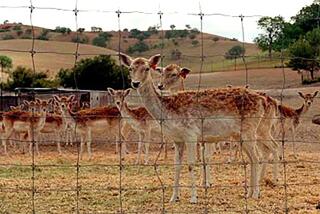Nation’s Oldest Wildlife Refuge Is Endangered : Golf, Polo Projects Under Way Near Pelican Island
- Share via
PELICAN ISLAND NATIONAL WILDLIFE REFUGE, Fla. — Two female brown pelicans snap their beaks, croak and flap their wings at two male interlopers swooping down to a bare mangrove branch.
The sea birds are fighting for precious space on 3-acre Pelican Island, the nation’s first wildlife refuge and the smallest parcel to receive the federal wilderness designation.
“We see it as sort of the flagship of the refuge system due to its age,” said Charles Lee, senior vice president of the Florida Audubon Society. “While we’ve drawn a federal boundary around those lands, the fact is they are being threatened on a daily basis by encroaching development.”
$800,000 Oceanfront Lots
As hundreds of pelicans and other birds fight for space on the sandy scrap of land in the refuge, developers on nearby Orchid Island have construction crews tearing into old grapefruit groves to make room for exclusive golf and polo club developments. Bare oceanfront lots with 125-foot frontage are offered for $800,000.
President Theodore Roosevelt created the refuge by proclamation in 1903 after hearing stories of plume hunters killing the island’s exotic birds for ladies’ hats and pleasure boaters firing away for sport.
Pelican Island remains what it was then: a choice rookery in the Indian River Lagoon, a mile-wide section of the Intracoastal Waterway that separates the mainland of central Florida near Sebastian from the citrus-rich barrier island of Orchid on the Atlantic Ocean.
“To you or I, it doesn’t look like there’s anything unusual about the island, except there’s almost no green. Pelicans will break off any green shoots for their nests,” said Dorn Whitmore, refuge spokesman for the U.S. Fish and Wildlife Service.
Only Island Is Protected
The refuge protects 4,700 acres, but the wilderness area shields only Pelican Island and three acres of surrounding water one to two feet deep.
The island is strictly for the birds--no human visitors are allowed except federal wildlife officers and occasional scientific parties.
Next to the refuge on the east, 200 to 225 units are proposed for the 400-acre Windsor Polo and Beach Club, which has drawn Britain’s Prince Charles as a player. To the southeast, an 18-hole golf course is the centerpiece of the planned 400-unit Orchid Island Golf & Beach Club.
“What we’ve got is a very viable, very valuable resource with a potential for a great deal of stress. The question is: ‘How do we manage it so we can keep on using it?’ ” asked Diane Barile, executive director of the Marine Resources Council, a 500-member group for Indian River Lagoon interests.
Lagoon Declines
She worries that the condition of the lagoon will continue to degrade, citing studies showing a 30% loss of sea grass beds and an 80% loss of filtering mangrove swamps in the area.
“We have the highest species diversity of any estuary in North America. We can outdo Chesapeake Bay or Puget Sound, any of those places,” Barile said. “If you’re out there in a sailboat or a small boat, you do get the feeling of release and being in a wild and lonely place and being a part of the land and the water itself. It’s really a magical place.”
More to Read
Sign up for Essential California
The most important California stories and recommendations in your inbox every morning.
You may occasionally receive promotional content from the Los Angeles Times.













